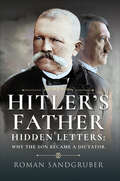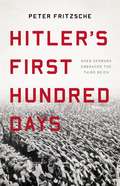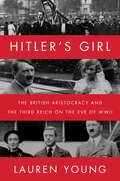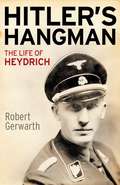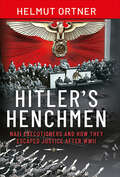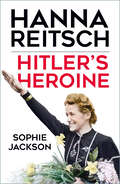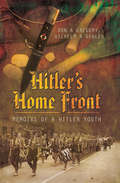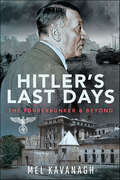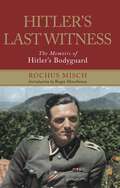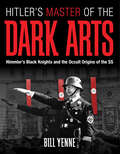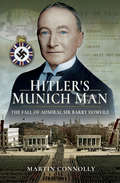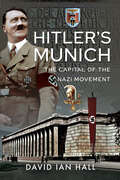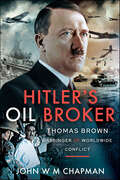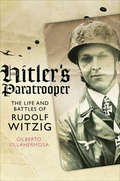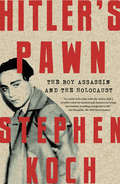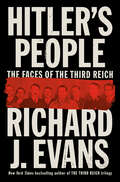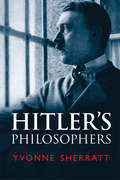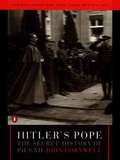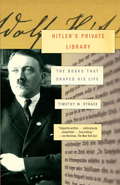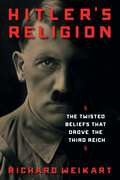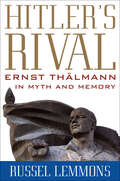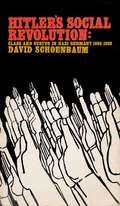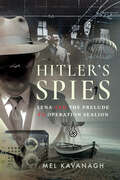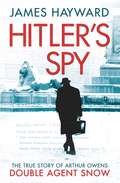- Table View
- List View
Hitler's Father: Hidden Letters: Why the Son Became a Dictator
by Roman SandgruberThe bundle of 31 letters, the pages of which had long yellowed with age, had lain hidden in the attic where they were found for over a century. Only when the razor-sharp script was examined further did historians discover just who had written them – and that person, Alois, was Adolf Hitler’s father. Born Alois Schicklgruber on 7 June 1837, the identity of his biological father still undisclosed, Alois eventually became a civil servant in the Austrian customs service. At around the age of 40, Alois changed his family name from Schicklgruber to Hitler – his infamous son being born some eleven years later. The contents of the re-discovered letters have allowed the renowned historian and author Roman Sandgruber to reassess the image that we have of Alois, offering the world a completely new and authentic impression of the man. In Hitler’s Father, Sandgruber re-examines Alois’ personality and how he significantly shaped the young Adolf. The letters also shed further light onto the everyday life of the Hitler family as whole, a story which is often characterized by myths, inventions and assumptions. They have given the author the opportunity to recount the childhood and youth of the future dictator, painting a dramatic picture of the ‘Führer’ growing up. These letters also help answer the question that is so often asked: How could a child from an Upper Austrian province, seemingly a failure and self-taught, rise to a position of such power? Indeed, Adolf Hitler’s father and ‘the province’ seemingly lay heavily on him until his suicide in the Führerbunker in 1945. The author examines how the young Hitler’s lowly upbringing may have affected him in the years that followed – years which shaped the history of the whole world.
Hitler's First Hundred Days: When Germans Embraced the Third Reich
by Peter FritzscheThis unsettling and illuminating history reveals how Germany's fractured republic gave way to the Third Reich, from the formation of the Nazi party to the rise of Hitler.Amid the ravages of economic depression, Germans in the early 1930s were pulled to political extremes both left and right. Then, in the spring of 1933, Germany turned itself inside out, from a deeply divided republic into a one-party dictatorship. In Hitler's First Hundred Days, award-winning historian Peter Fritzsche offers a probing account of the pivotal moments when the majority of Germans seemed, all at once, to join the Nazis to construct the Third Reich. Fritzsche examines the events of the period -- the elections and mass arrests, the bonfires and gunfire, the patriotic rallies and anti-Jewish boycotts -- to understand both the terrifying power the National Socialists exerted over ordinary Germans and the powerful appeal of the new era they promised.Hitler's First Hundred Days is the chilling story of the beginning of the end, when one hundred days inaugurated a new thousand-year Reich.
Hitler's Girl: The British Aristocracy and the Third Reich on the Eve of WWII
by Lauren YoungA timely, riveting book that presents for the first time an alternative history of 1930s Britain, revealing how prominent fascist sympathizers nearly succeeded in overturning British democracy—using the past as a road map to navigate the complexities of today’s turn toward authoritarianism.Hitler’s Girl is a groundbreaking history that reveals how, in the 1930s, authoritarianism nearly took hold in Great Britain as it did in Italy and Germany. Drawing on recently declassified intelligence files, Lauren Young details the pervasiveness of Nazi sympathies among the British aristocracy, as significant factions of the upper class methodically pursued an actively pro-German agenda. She reveals how these aristocrats formed a murky Fifth Column to Nazi Germany, which depended on the complacence and complicity of the English to topple its proud and long-standing democratic tradition—and very nearly succeeded.As she highlights the parallels to our similarly treacherous time, Young exposes the involvement of secret organizations like the Right Club, which counted the Duke of Wellington among its influential members; the Cliveden Set, which ran a shadow foreign policy in support of Hitler; and the shocking four-year affair between socialite Unity Mitford and Adolf Hitler.Eye-opening and instructive, Hitler’s Girl re-evaluates 1930s England to help us understand our own vulnerabilities and poses urgent questions we must face to protect our freedom. At what point does complacency become complicity, posing real risk to the democratic norms that we take for granted? Will democracy again succeed—and will it require a similarly cataclysmic event like World War II to ensure its survival? Will we, in our own defining moment, stand up for democratic values—or will we succumb to political extremism?
Hitler's Hangman: The Life of Heydrich
by Robert GerwarthA chilling biography of the head of Nazi Germany&’s terror apparatus, a key player in the Third Reich whose full story has never before been told. Reinhard Heydrich is widely recognized as one of the great iconic villains of the twentieth century, an appalling figure even within the context of the Nazi leadership. Chief of the Nazi Criminal Police, the SS Security Service, and the Gestapo, ruthless overlord of Nazi-occupied Bohemia and Moravia, and leading planner of the "Final Solution," Heydrich played a central role in Hitler's Germany. He shouldered a major share of responsibility for some of the worst Nazi atrocities, and up to his assassination in Prague in 1942, he was widely seen as one of the most dangerous men in Nazi Germany. Yet Heydrich has received remarkably modest attention in the extensive literature of the Third Reich. Robert Gerwarth weaves together little-known stories of Heydrich's private life with his deeds as head of the Nazi Reich Security Main Office. Fully exploring Heydrich's progression from a privileged middle-class youth to a rapacious mass murderer, Gerwarth sheds new light on the complexity of Heydrich's adult character, his motivations, the incremental steps that led to unimaginable atrocities, and the consequences of his murderous efforts toward re-creating the entire ethnic makeup of Europe. &“This admirable biography makes plausible what actually happened and makes human what we might prefer to dismiss as monstrous.&”—Timothy Snyder, Wall Street Journal &“[A] probing biography…. Gerwarth&’s fine study shows in chilling detail how genocide emerged from the practicalities of implementing a demented belief system.&”—Publishers Weekly &“A thoroughly documented, scholarly, and eminently readable account of this mass murderer.&”—The New Republic
Hitler's Henchmen: Nazi Executioners and How They Escaped Justice After WWII
by Helmut OrtnerHelmut Ortner reveals a staggering history of perpetrators, victims and bystanders in Hitler’s Germany. He explores the shocking evidence of a merciless era – and of the shameful omissions of post-war German justice. Johann Reichhart was a state-appointed judicial executioner in Bavaria from 1924 until the end of the war in Europe. During the Nazi era, he executed numerous people who were sentenced to death for resisting National Socialism, including many of those involved in the 20 July 1944 bomb plot on Adolf Hitler. As a member of the SS-Totenkopfverbände, the SS organisation responsible for administering the concentration and extermination camps, Arnold Strippel served at a number of locations during his rise to the rank of SS-Obersturmführer. These included Natzweiler-Struthof, Buchenwald, Majdanek, Ravensbrück and Neuengamme, where he was responsible for murdering the victims of a series of tuberculosis medical experiments. Like Reichhart, Erich Schwinge was also involved in the legal sphere during the Third Reich. A German military lawyer, in 1931 he became a professor of law and, from 1936, wrote the legal commentary on German military criminal law that was decisive during the Nazi era. Aside from the part they played in Hitler’s regime, these three men all had one further thing in common – they survived the war and restarted their careers in Adenauer’s Federal Republic of Germany. In Hitler’s Henchmen, Helmut Ortner uncovers the full stories of Reichhart, Strippel, Schwinge and others like them, Nazi perpetrators who enjoyed post-war careers as judges, university professors, doctors and politicians. Had they been gutless cogs in the machinery of the Nazi state, or ideologized persecutors? Ortner reveals that it was not only their Nazi pasts that were forgotten, but how the suffering of the victims, including resistance fighters such as Georg Elser and Maurice Becaud, and their relatives was suppressed and ignored.
Hitler's Heroine: Hanna Reitsch
by Sophie JacksonHanna Reitsch longed to fly. Having broken records and earned the respect of the Nazi regime, she was the first female Luftwaffe test pilot, and eventually became Adolf Hitler’s personal heroine.An ardent Nazi, Hanna was prepared to die for the cause, first as a test pilot for the dangerous V1 flying bombs and later by volunteering for a suggested Nazi ‘kamikaze’ squadron. After her capture she complained bitterly of not being able to die with her leader, but she went on to have a celebrated post-war flying career. She died at the age of 67, creating a new mystery – did Hanna kill herself using the cyanide pill Hitler had given her over thirty years earlier? Hitler’s Heroine reveals new facts about the mysterious pilot and cuts through the many myths that have surrounded her life and death, bringing this fascinating woman back to life for the twenty-first century.
Hitler's Home Front: Memoirs of a Hitler Youth
by Don A Gregory Wilhelm R GehlenA &“candid and revealing memoir shows a normal boy and a family at war and in its aftermath, determined to do what it took to survive . . . fascinating&” (The Great War). When Adolf Hitler and the Nazi Party came into power in 1933, he promised the downtrodden, demoralized, and economically broken people of Germany a new beginning and a strong future. Millions flocked to his message, including a corps of young people called the Hitlerjugend—the Hitler Youth. By 1942 Hitler had transformed Germany into a juggernaut of war that swept over Europe and threatened to conquer the world. It was in that year that a nine-year-old Wilhelm Reinhard Gehlen, took the &‘Jungvolk&’ oath, vowing to give his life for Hitler. This is the story of Wilhelm Gehlen&’s childhood in Nazi Germany during World War II and the awful circumstances which he and his friends and family had to endure during and following the war. Including a handful of recipes and descriptions of the strange and sometimes disgusting food that nevertheless kept people alive, this book sheds light on the truly awful conditions and the twisted, mistaken devotion held by members of the Hitler Youth—that it was their duty to do everything possible to save the Thousand Year Reich.
Hitler's Last Days: The Führerbunker & Beyond
by Mel KavanaghStudies Hitler's final days in the Fuhrerbunker looking at the Nazi leader's state of mind during the war and the effect if had on his physical state. Berlin, April 1945. After almost six years of war, the end is nigh for the Nazi’s. The Russians are closing in on the German capital and Hitler is holed up in the Fuhrerbunker in the city. There was an eclectic mix of individuals residing in the bunker with Hitler at this time including senior Nazi officers, Hitler’s personal protection squad, soldiers, civilians, children and even a female test pilot but how did they fair at the end? Not all died or were captured. Hitler’s Last Days studies Hitler's final days in the Fuhrerbunker looking at the Nazi leaders' state of mind during the war and the effect if had on his physical state, despite only being 56 at the time of his death it was said by many that he looked somewhat older. But how did Hitler really die? Or did he escape as some evidence has previously suggested? A wealth of diverse research material has been used to create an account that comes from a different angle on a popular WWII story.
Hitler's Last Witness: The Memoirs of Hitler's Bodyguard
by Rochus MischThis memoir of Hitler&’s personal bodyguard presents &“convincing first-person testimony of the dictator&’s final desperate months, days and hours&” (Huffington Post). After being seriously wounded in the 1939 Polish campaign, Rochus Misch was invited to join Hitler&’s SS-bodyguard. There he served until the war&’s end as Hitler&’s bodyguard, courier, orderly, and, finally, as Chief of Communications. On the Berghoff terrace, he watched Eva Braun organize parties, observed Heinrich Himmler and Albert Speer, and monitored telephone conversations from Berlin to the East Prussian Headquarters on July 20, 1944—after the attempt on Hitler&’s life. As the Allied forces closed in, Misch was drawn into the Führerbunker with the last of the faithful. He remained in charge of the bunker switchboard as his duty required, even after Hitler committed suicide. Misch knew Hitler the private man. His memoirs offer an intimate view of life in close attendance to Hitler and of the endless hours deep inside the bunker. They also provide new insights into military events—such as Hitler&’s initial feeling that the 6th Army should pull out of Stalingrad. Shortly before he died, Misch wrote a new introduction for this English-language edition.
Hitler's Master of the Dark Arts: Himmler's Black Knights and the Occult Origins of the SS
by Bill YenneA history of Nazi Germany’s SS and its leader examining the groups mystical cult aspects and Himmler’s rise through the ranks of power.Hitler’s Nazi Party, at its evil roots, embraced a bizarre interpretation of ancient European paganism, blending it with fragments of other traditions from sources as diverse as tenth-century Saxon warlords, nineteenth-century spiritualism, and early-twentieth-century fringe archeology. Even the swastika, the hated symbol of Nazism, had its roots in ancient symbolism, its first recorded appearance carved into a mammoth tusk twelve thousand years before Hitler came to power.At the heart of the evil was Hitler’s “witch doctor,” Heinrich Himmler, and his stranger-than-fiction cult, the deadly SS. The mundanely named Schutzstaffel, literally “protective squadron,” was the very essence of Nazism, and their threatening double lightning bolt was one of the most dreaded symbols of the Third Reich. With good reason: what the SS was truly protecting was the ideology of Aryan superiority.Hitler’s Master of the Dark Arts is the first history of the SS and its leader to focus on the mystical cult aspects of the organization. It follows Himmler’s transformation of the SS from a few hundred members in 1929 to over fifty thousand black-uniformed Aryans by the mid-1930s. Concurrent with its expansion and its eventual independence from the brown shirts of the SA, Himmler infused the Black Knights with a mishmash of occult beliefs and lunatic-fringe theories that would have been completely laughable—except that they were also used to justify the Final Solution.
Hitler's Munich Man: The Fall of Admiral Sir Barry Domvile
by Martin ConnollyA &“fascinating&” account of the British director of Naval Intelligence who was interned during the Second World War as a Nazi sympathizer (The Armourer). Between the First and Second World Wars, there was a growth of fascism in Britain and anxiety about revolution was in the air. Concerns of a possible Fascist attempt to overthrow the established order were high, not to mention the rise of Hitler and the threat of invasion. With secret clubs and clandestine meetings now a threat, the security services decided to infiltrate their ranks. Sir Barry Domvile had served with honor during the First World War and had risen to director of Naval Intelligence. He became involved with Oswald Mosley and other far right leaders, also visiting prominent Nazis in Germany with whom he became enamored and formed &“The Link,&” a far right, pro-German organization. Concerns were raised and in 1940 he, along with his wife and son, were detained and imprisoned without trial under Regulation 18B of the Defence (General) Regulations 1939, under suspicion of being involved in a secret plot to bring in a Fascist Government. Hitler&’s Munich Man gives a detailed account of Domvile&’s background, detention, and hearings that were held behind closed doors and reveals the extent of his Fascism, pro-German attitudes and anti-Semitism. The first book to throw a spotlight on the saga, it examines his writings, both open and issued under a pseudonym, and considers the legitimacy of his detention. With photographs from the German archives, substantial coverage using the Secret Service files, Domvile&’s personal diaries, and other sources, the book will illuminate and inform the reader.
Hitler's Munich: The Capital of the Nazi Movement
by David Ian HallAn acclaimed historian of twentieth century Germany provides a vivid account of Hitler’s rise to power and its intimate connection to the Bavarian capital.The immediate aftermath of the Great War and the Versailles Treaty created a perfect storm of economic, social, political and cultural factors which facilitated the rapid rise of Adolf Hitler’s political career and the birth of the National Socialist German Worker’s Party. The breeding ground for this world-changing evolution was the city of Munich. In Hitler’s Munich, renowned historian David Ian Hall examines the origins and growth of Hitler’s National Socialism through the lens of this unique city. By connecting the sites where Hitler and his accomplices built the movement, Hall offers a clear and concrete understanding of the causes, background, motivation, and structures of the Party. Hitler’s Munich is a cultural and political portrait of the city, a biography of the Fuhrer, and a history of National Socialism. All three interacted in this expertly rendered exploration of their interconnections and significance.
Hitler's Oil Broker: Thomas Brown, Harbinger of Worldwide Conflict
by John WM ChapmanThe biography of Thomas Brown,who provided the template for a successful search by the German navy for oil access. Thomas Brown is an unknown figure of Scottish origin who played a significant role in the onset and development of both world wars in the first half of the 20th century. In the First World War he contributed to the Anglo-German conflict in the Middle East particularly in his switch from UK to German nationality in 1914 by contributing directly to the expansion of German imperialism in the Persian Gulf and Ottoman Empire. His most important role was in providing logistical support to German and Turkish forces in support of the Turkish jihad in November 1914. Despite his arrest by MI5 as a suspected traitor in 1919, he returned to Germany as a business middleman aided by former political and military colleagues in the Weimar Republic. After promoting German interests in Iran, he was able as a company director to represent German steel manufacturers who bought into the Anglo-Italian British Oil Development Company (BOD) in Iraq. He helped to obtain an oil concession from independent in Iraq in 1932, and used his skills as a negotiator with British, German and Arab speakers to promote a large oil strike and major expansion of the company in 1935. It is here that the German-Italian axis comes to center-stage. Brown initially rejected Italian approaches to take over the company - exactly when Mussolini was trying to conquer Abyssinia - in favor of support for the UK investors, Lord Glenconner and Sir Percy Hunting. Brown was not fully aware of the maneuvering by the Hitler regime since autumn 1933 to promote alliances with Britain, Italy and Japan against the USSR and France, which ended in December 1935 with Hitler's preference for Italy. This was accelerated by Gestapo investigations into Italian involvement and Hitler's calculation that it would promote divisions among former allies and decrease German dependence on the world oil economy they dominated. Access to oil was key to military and political success. Brown belatedly understood that Britain was opposed to permitting Italy and Germany access to to key raw materials. Brown reported directly to Berlin even though he was mistakenly identified as a 'Scottish Jew' but he failed to recognize that Hitler's support for Italy enabled access to Italian oil while maintaining domestic sources of fuel for rearmament of the army and air force. Brown was terminally ill by 1936 but had provided the template for a successful search by the German navy for access to oil, independent of the Anglo-American dominance of the world oil industry.
Hitler's Paratrooper: The Life and Battles of Rudolf Witzig
by Gilberto Villahermosa&“A valuable study . . . a must-read for everybody interested in the topic of German Fallschirmjäger in the Second World War&” (Volker Griesser, author of The Lions of Carentan). Rudolf Witzig entered the history books as the heroic captor of Belgium&’s supposedly impregnable fortress Eben Emael in May 1940—the first time that glider-borne troops were used in the war. To many people, he is also known as the commander of the battle group that fired the first shots of the Tunisian campaign. Remarkably, next to nothing has been written about him as an individual. This biography, completed with the full support of Witzig&’s widow and son, is a comprehensive history of the man and also provides important new detail on the German parachute arm that he served. In the course of his service, Witzig was awarded the coveted Knight&’s Cross of the Iron Cross, even though he had not yet earned the Iron Crosses 2nd and 1st class. To resolve the problem, he was awarded all three on the spot. Witzig was involved in Operation Mercury, the invasion of Crete, but was injured during the fighting. After his recovery, he was sent to Tunisia where he was credited with several successful defensive actions. He ended the war in captivity, surrendering to the Allies on May 8, 1945, the day after his name was placed on the Honour Roll of the Luftwaffe. &“A gripping biography, providing a tough, gritty and compelling study of a German soldier.&” —Firetrench &“A unique, well-written and impeccably researched account of the Third Reich&’s evolving fortunes as witnessed on numerous battlefronts by a highly decorated Fallschirmjäger officer.&” —Mark J. Reardon, author of Defending Fortress Europe
Hitler's Pawn: The Boy Assassin and the Holocaust
by Stephen KochA remarkable story of a forgotten seventeen–year–old Jew who was blamed by the Nazis for the anti–Semitic violence and terror known as the Kristallnacht, the pogrom still seen as an initiating event of the HolocaustAfter learning about Nazi persecution of his family, Herschel Grynszpan (pronounced Greenspan) bought a small handgun and on November 7, 1938, went to the German embassy and shot the first German diplomat he saw. When the man died two days later, Hitler and Goebbels made the shooting their pretext for the state–sponsored wave of antiSemitic terror known as Kristallnacht, still seen by many as an initiating event of the Holocaust.Overnight, Grynszpan, a bright but naive teenager, was front–page news and a pawn in a global power struggle.
Hitler's People: The Faces of the Third Reich
by Richard J Evans&“A fascinating and instructive book . . . elegantly written and perceptive.&” —Wall Street Journal&“Kaleidoscopic . . . A fascinating exploration of individual agency that never loses sight of the larger context . . . Just the kind of probing, nuanced and unsparing study to help us think things through.&” —The New York TimesThrough a connected set of biographical portraits of key Nazi figures that follows power as it radiated out from Hitler to the inner and outer circles of the regime&’s leadership, one of our greatest historians answers the enduring question, how does a society come to carry out a program of unspeakable evil?Richard Evans, author of the acclaimed The Third Reich Trilogy and over two dozen other volumes on modern Europe, is our preeminent scholar of Nazi Germany. Having spent half a century searching for the truths behind one of the most horrifying episodes in human history, in Hitler&’s People, he brings us back to the original site of the Nazi movement: namely, the lives of its most important members.Working in concentric circles out from Hitler and his closest allies, Evans forms a typological framework of Germany society under Nazi rule from the top down. With a novelist&’s eye for detail, Evans explains the Third Reich through the personal failings and professional ambitions of its members, from its most notorious deputies—like Goebbels, the regime&’s propagandist, and Himmler, the Holocaust&’s chief architect—to the crucial enforcers and instruments of the Nazi agenda that history has largely forgotten—like the schoolteacher Julius Streicher and the actress Leni Riefenstahl. Drawing on a wealth of recently unearthed historical sources, Hitler&’s People lays bare the inner and outer lives of the characters whose choices led to the deaths of millions.Nearly a century after Hitler&’s rise, the leading nations of the West are once again being torn apart by a will to power. By telling the stories of these infamous lives as human lives, Evans asks us to grapple with the complicated nature of complicity, showing us that the distinctions between individual and collective responsibility—and even between pathological evil and rational choice—are never easily drawn.
Hitler's Philosophers
by Yvonne SherrattHitler had a dream to rule the world, not only with the gun but also with his mind. He saw himself as a "philosopher-leader" and astonishingly gained the support of many intellectuals of his time. In this compelling book, Yvonne Sherratt explores Hitler's relationship with philosophers and uncovers cruelty, ambition, violence, and betrayal where least expected--at the heart of Germany's ivory tower.Sherratt investigates international archives, discovering evidence back to the 1920s of Hitler's vulgarization of noble thinkers of the past, including Kant, Nietzsche, and Darwin. She reveals how philosophers of the 1930s eagerly collaborated to lend the Nazi regime a cloak of respectability: Martin Heidegger, Carl Schmitt, and a host of others. And while these eminent men sanctioned slaughter, Semitic thinkers like Walter Benjamin and opponents like Kurt Huber were hunted down or murdered. Many others, such as Theodor Adorno and Hannah Arendt, were forced to flee as refugees. The book portrays their fates, to be dispersed across the world as the historic edifice of Jewish-German culture was destroyed by Hitler.Sherratt not only confronts the past; she also tracks down chilling evidence of continuing Nazi sympathy in Western Universities today.
Hitler's Pope: The Secret History of Pius XII
by John CornwellThe "explosive" (The New York Times) bestseller-now with a new introduction by the author <P> When Hitler's Pope, the shocking story of Pope Pius XII that "redefined the history of the twentieth century" (The Washington Post ) was originally published, it sparked a firestorm of controversy both inside and outside the Catholic Church. Now, award-winning journalist John Cornwell has revisited this seminal work of history with a new introduction that both answers his critics and reaffirms his overall thesis that Pius XII, now scheduled to be canonized by the Vatican, weakened the Catholic Church with his endorsement of Hitler-and sealed the fate of the Jews in Europe.
Hitler's Priestess
by Nicholas Goodrick-ClarkeIn this window onto the roots and evolution of international neo-Nazism, Nicholas Goodrick-Clarke reveals the powerful impact of one of fascism's most creative minds. Savitri Devi's influence on neo-Nazism and other hybrid strains of mystical fascism has been continuos since the mid-1960s. A Frenchwoman of Greek-English birth, Devi became an admirer of German National Socialism in the late 1920s. Deeply impressed by its racial heritage and caste-system, she emigrated to India, where she developed her racial ideology, in the early 1930s. Her works have been reissued and distributed through various neo-Nazi networks and she has been lionized as a foremother of Nazi ideology. Her appeal to neo-Nazi sects lies in the very eccentricity of her thought - combining Aryan supremacism and anti-Semitism with Hinduism, social Darwinisn, animal rights, and a fundamentally biocentric view of life - and has resulted in curious, yet potent alliances in radical ideology. As one of the earliest Holocaust deniers and the first to suggest that Adolf Hitler was an avatar-- a god come to earth in human form to restore the world to a golden age - Devi became a fixture in the shadowy neo-Nazi world. In Hitler's Priestess, Nicholas Goodrick-Clarke examines how someone with so little tangible connection to Nazi Germany became such a powerful advocate of Hitler's misanthropy. Hitler's Priestess illuminates the life of a woman who achieved the status of a prophetess for her penchant for redirecting authentic religious energies in the service of regenerate fascism.
Hitler's Private Library: The Books That Shaped His Life
by Timothy W. RybackHe was, of course, a man better known for burning books than collecting them and yet by the time he died, aged 56, Adolf Hitler owned an estimated 16,000 volumes -- the works of historians, philosophers, poets, playwrights and novelists. A passionate reader, his worldview was largely formed by the books he read. For more than fifty years the remnants of Hitler's private library occupied shelf-space in climate-controlled obscurity in the rare book division of the Library of Congress in Washington. Timothy Ryback is the first to systematically explore this remarkable collection, as well as several other caches which he subsequently discovered in Europe and elsewhere. The volumes in Hitler's library are fascinating in themselves but it is the marginalia -- the comments, the exclamation marks, the questions and underlinings, even the dirty thumbprints on the pages of a book he read in the trenches of the First World War -- which are so revealing. Together they take us closer to the man and his thinking than ever seemed possible. Hitler's Private Library provides us with a remarkable view of Hitler's evolution u and unparalleled insights into his emotional and intellectual world. Utterly compelling, it is also a landmark in our understanding of the Third Reich.
Hitler's Religion: The Twisted Beliefs that Drove the Third Reich
by Richard WeikartFor a man whom history can never forget, Adolf Hitler remains a persistent mystery on one front-his religious faith. Atheists tend to insist Hitler was a devout Christian. Christians counter that he was an atheist. And still others suggest that he was a practicing member of the occult. <P><P>None of these theories are true, says historian Richard Weikart. Delving more deeply into the question of Hitler's religious faith than any researcher to date, Weikart reveals the startling and fascinating truth about the most hated man of the 20th century: Adolf Hitler was a pantheist who believed nature was God. <P><P>In Hitler's Religion, Weikart explains how the laws of nature became Hitler's only moral guide-how he became convinced he would serve God by annihilating supposedly "inferior" human beings and promoting the welfare and reproduction of the allegedly superior Aryans in accordance with racist forms of Darwinism prevalent at the time.
Hitler's Rival: Ernst Thälmann in Myth and Memory
by Russel Lemmons“Fascinating material . . . This book will likely be the last word and the standard work on the Thälmann myth and its role in East German history.” —Catherine Epstein, author of Nazi Germany: Confronting the MythsThroughout the 1920s, German politician and activist Ernst Thälmann (1886–1944) was the leader of the largest Communist Party organization outside the Soviet Union. Thälmann was the most prominent left-wing politician in the country’s 1932 election and ran third in the presidential race after Hitler and von Hindenberg. After the Nazi Party’s victory in that contest, he was imprisoned and held in solitary confinement for eleven years before being executed at Buchenwald concentration camp in 1944 under the Führer’s direct orders.Hitler’s Rival examines how the Communist Party gradually transformed Thälmann into a fallen mythic hero, building a cult that became one of their most important propaganda tools in central Europe. Author Russel Lemmons analyzes the party intelligentsia’s methods, demonstrating how they used various media to manipulate public memory and exploring the surprising ways in which they incorporated Christian themes into their messages. Examining the facts as well as the propaganda, this unique volume separates the intriguing true biography of the cult figure from the fantastic myth that was created around him.“Lemmons analyzes in great detail the myth and legend that formed around Ernst Thälmann, who became the leader of the German Communist Party in 1925 and was a dominant politician in Weimar Germany until imprisoned by the Nazis in 1933. This comprehensive study, which treats the years before the war ended for the first time, is thoroughly researched and well written; it will be a standard work on the subject.” —G. P. Blum, Professor Emeritus, University of the Pacific
Hitler's Social Revolution: Class and Status in Nazi Germany 1933-1939
by David SchoenbaumBeginning with Germany's social situation after World War I, David Schoenbaum shows how Hitler improvised a program that apparently offered something to everyone--above all, the mirage of a classless society. In fact, the gap between the ideology of the Reich and its actual character was enormous. But under the spell of the mirage, the will to resist was undermined by an accelerating process of social disintegration.
Hitler's Spies: Lena and the Prelude to Operation Sealion
by Mel KavanaghThe incredible true story of the first four Nazi spies to infiltrate British soil is revealed in this WWII history.After the swift takeover of France and the Low Countries, Nazi Germany was on the crest of a wave. Only the United Kingdom stood in its way. Hitler quickly devised plans for the invasion of England, codenamed Operation Sealion. To lay the groundwork, a team of spies would be sent in advance to act as pathfinders for the incoming forces. Codenamed Operation Lena, this phase of the plan was considered a suicide mission by German military intelligence. They had only thirty days to recruit and train agents who had a less than convincing grasp of English language or customs. Hitler’s Spies revels the story of the first four agents to arrive on English soil—collectively known by MI5 as “The Brussels Four.”Using a wealth of primary materials, including newly declassified sources, Mel Kavanagh sheds light on one of the most audacious yet little-known operations of the Second World War, in which undertrained men were sent behind enemy lines at a time when Britain was gripped by spy paranoia.
Hitler's Spy
by James HaywardOriginally published as Double Agent Snow, Hitler's Spy is the paperback edition, which tells of how on the eve of the outbreak of the Second World War the double-agent Arthur Owens, codenamed SNOW, is summoned to Berlin and appointed Hitler's chief spy in Britain. Days later he finds himself in Wandsworth prison, betrayed by the wife he traded for a younger model, and forced to transmit false wireless messages for MI5 to earn his freedom - and avoid the hangman's noose. A vain and devious anti-hero with no moral compass, Owen's motives were status, money and women. He mixed fact with fiction constantly, and at times insisted that he was a true patriot, undertaking hazardous secret missions for his mother country; at other times, Owens saw himself as a daring rogue agent, outwitting British Intelligence and loyal only to the Fatherland. Yet in 1944, as Allied troops stormed the beaches of Normandy on D-Day, Hitler was caught unawares, tricked into expecting the invasion across the Pas de Calais in a strategic deception played out by Owens and the double-cross agents of MI5. For all his flaws, Agent Snow became the traitor who saved his country. Based on recently de-classified MI5 files and previously unpublished sources, Hitler's Spy is the story of a secret Battle of Britain, fought by Snow and his opposing spymasters, Thomas 'Tar' Robertson of MI5 and Nikolaus Ritter of the Abwehr, as well as the tragic love triangle between Owens, his wife Irene, and his mistress Lily Funnell. The evocative, fast-paced narrative moves from seedy south London pubs to North Sea trawlers, from chic Baltic spa resorts to Dartmoor gaol, populated by a colourful rogue's gallery of double-cross agents.
